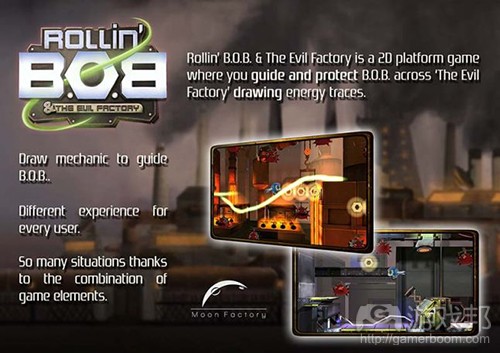如何去设计只属于你自己的One Page
作者:David Osorio
首先,我想要解释的是“One Page”指的是简短,有效且具有吸引力地描述我们项目主要功能的文件。
这一文件通常都会发送或递交给需要了解我们项目特殊卖点(USP)的发行商或投资者。所以我们总是希望能够简单且清楚地描述我们的游戏并添加一些必要的信息:
概念:简短解释游戏/产品的句子。
产品信息:游戏类型,平台,目标用户等内容。
总结:关于游戏情节和目标的更深入的信息。
概述:更详细地解释游戏的概念和一些动态内容。
USP:我们的游戏与其它竞争者的主要区别。
你必须确保其中的内容至少需要包含概念,产品信息和卖点,并且One Page能够满足你想要传达某些信息的需求。当然这里并不存在唯一的标准。你可以按照自己的想法进行创造,只要你认为自己所创造的内容能够更有效地吸引浏览这一内容的读者的注意便可。
这主要是关于内容。但是基于怎样的形式呢?形式是非常重要的。我们的用户,也就是投资者和发行商没有大量时间去浏览邮件中的所有One Page或各种宣传内容。所以我们必须真正有效地去传达我们的项目:
概要–One Page需要在一页纸范围内提供有关游戏的清楚且简要的理念。这并不意味着我们需要将所有信息聚集在一张纸中。相反地我们应该:
清楚且有序。你应该让读者的眼睛能够轻松被文件所吸引,为此你需要有效组织内容布局。就像我们便非常看重每一段每一行内容之间的空格。这是有效传达我们的理念的一种基本做法。
视觉识别:最后但也同样重要的是,这是吸引我们用户注意并在他们心中留下印象的一种方法,而logo,页面或其它图像内容将能代表我们的游戏,它的价值,风格以及我们想要传达的信息。这一切也能让读者想起我们的项目。
我将在此提供我自己所创造的一些One Page文件。这包含了我在上文中所提到的一些要点,但因为是基于不同条件所创造的不同One Page,所以它们所包含的内容也是不同的。
例如,第一份One Page是要发送给发行商的,对方将在办公室或家里轻松地阅读该内容,所以我可以写下更多信息。而第二份和第三份One Page是要在宣传期间递交出去的,即我将通过交谈的形式去传递One Page的内容,所以要比第一份更简洁一些。
这里的要点便在于,我们必须适应不同的用户和环境去创造不同的One Page。如果我们的用户既包括游戏设计师也包括一些投资者,情况也就大不相同。因为前者需要关于游戏的更深入信息,而后者想看到的是能让游戏突显于竞争对手中的内容。
最后,我想要分享更多有关One Page的建议:
了解你的用户:做些研究去了解他们。这能够帮助你清楚他们的看法并努力去迎合他们。如此你便会清楚呈现你的主要理念的最佳方法。
清楚地呈现一个主要理念。了解我们的分享对象能让我们更有效地创造推销游戏的信息。而围绕着这一理念去创造One Page并创造图像能够更有效地支撑主题。
让其足够“耀眼”!One Page的主要目的便是销售理念,所以这是一种非常纯粹的市场营销方式。你应该利用所有资源去创造更加吸引人的信息,例如使用镀膜纸让One Page更持久且更吸引人;并突出表示那些更重要的元素。
用户总是想要了解更多信息。所以在这里你还可以附加自己的名片,或者你也可以在游戏网站或邮件中添加二维码让用户能够找到你。
注册。如果你想要真正拥有自己的理念,请确保你已经注册了所有内容并在文件中添加了相关信息。如果拥有一份知识共享许可协议便能够清楚地证实这是只属于你的理念。
使用自己的东西。如果你能够为最终理念创造更多价值和内容的话便会更有说服力。但如果你做不到这点也不要去使用别人注册过的材料或来自公共平台的照片。
迭代。先创造第一个版本并验证所有内容都是合理的。询问别人的意见并再次进行完善。不断重复这一过程直至你对最终内容感到真正满意为止。
(本文为游戏邦/gamerboom.com编译,拒绝任何不保留版权的转发,如需转载请联系:游戏邦)
How to design your One Page
by David Osorio
First of all, I would to explain that a ‘One Page’ is a document which shows the main features of our project in a brief, attractive and effective way.
On regular basis, this document is send or hanged to a publisher or investor who needs to know at-a-glance about the USP’s (Unique Selling Points) of our project. So we want to stand out and keep it simple to send a clear idea about the game, adding as content the essential information:
Concept: the sentence which explain the game/product brieftly.
Product info.: game genre, platform and target audience should appear here.
Summary: a more in-depth info about the plot and the objetives in the game.
Outline: it explains a bit more about the concept and dynamic of the game.
USP’s (Unique Selling Points): the main points which make our game different from the competition.
Content should be always composed of, at least, the concept, product info. and USP’s, but One Page responds to yours needs to communicate something. It is not always the same formula. Feel free to configurate it as you want, as long as it feels more efficient to communicate to your audicence.
This is about the content. But, what about the form? The form is nearly as much important as what we want to say. Our audience, investors and publishers, have no time for dozens of One Page that stack up in their email or several pitches that the have to heard along the day. Our objetive has no changed at all; we have to communicate our project effectively, so we should do it:
Brief: One Page needs to provide a quick and clear idea about the game in a page long. This does not mean that we should accumulate tons of info in one sheet. Better we be…
Clean and ordered. Readers’ eyes should travel easily inside the document, so consider carefully how you organize the pieces in the layout. We better respect the margins, spaces among paragraphs and lines. Here it is basic to transmit our ideas with an strong…
Visual Identity. Last but not least, this frame it is a great opportunity to stand out and leave a mark in the audience. Logo, screens and other art pieces should inform about our game, their values, its style and reinforce our message. All these will lead the reader to remember the project.
Here I provide you some examples of One Page documents made by myself. These cover the points we talked about some lines above, but they do not have the same content since they are different One Pages for different situations.
For example, the first one was due to be send to a publisher, which means that I can write down more info. since someone will read it (or not!) in the comfort of his office or home. Second and third were supposed to be hanged out during a pitch, so they are more brief than the first one, since I will complement the One Page information with the talk.
The take here is that we have to adapt the One Page to the audience and its circunstances. It is not the same if our audience is composed of game designers that if only came to the pitch some investors. The former will expect a in-depth info. about the game and the latter will be OK with some high level info and what makes the game stands out from competence.
Finally, I am going to share some tips more:
Know your audience: do some research and learn about them. This will help you to know how they think and put into their shoes. Here you will chose the right approach to present your main idea.
Present a main and clear idea. Knowing who we are talking to will allow us to create a message more efficient to sell our game. Build the One Page around that idea and make the art pieces so as to support the theme (as you can see, in the second and third examples that I provided, both One Pages are themed with space and industrial motives, respectively).
Make it shine! One Page is pure marketing since its very purpose is to sell an idea. Use all kind of resources to make more appealing the message. I.e.: use laminated paper so as to be more durable and eye-catching; stands out the more relevant elements with glowing, for example.
They want to know more. Here business card has more use but, what if someone interested has lost it? Or maybe you do not have one yet! Let them come back to you again by adding a QR code to game’s site or a corporative email.
Register it. If you want to own your idea, make sure that you have registered everything and add some reference to it in the document. It could work fine a Creative Commons license just to prove it is yours.
Use your own stuff. Generates more value and the approach to the final idea is more convincing. If you cannot, avoid using registered material and get public domain photos.
Iterate. Get one first version; verify everything is OK. Ask for someone’s opinion and go over it again with possible improvements. Repeat this until your are satisfied with the result and it is fully understandable for your next reader.
I encourage you to check some more examples as this one taken from ‘Level Up!: The Guide to Great Video Game Design’ (a great book for learn game design, indeed) or this talk from GDC 2010 which I came up at the same time I wrote the article.(source:gamasutra)
上一篇:草根营销对一家小型工作室的重要性










































 闽公网安备35020302001549号
闽公网安备35020302001549号